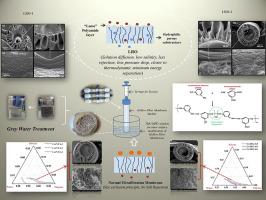Chemical Engineering Journal ( IF 13.3 ) Pub Date : 2020-12-02 , DOI: 10.1016/j.cej.2020.127929 Shubham Lanjewar , Anupam Mukherjee , Priyesh Khandewal , Asim K. Ghosh , Aditi Mullick , Siddhartha Moulik , Anirban Roy

|
Greywater recycling is a promising alternative to purify a relatively clean stream at a lower energy penalty. In the present work, greywater treatment through “loose” thin-film composite (TFC) reverse osmosis (RO) membranes have been attempted. Polymer interactions between cellulose acetate (CA) and additives like polyvinyl pyrrolidone (PVP) and polyethylene glycol (PEG) have been studied along with their miscibilities in n-methyl pyrrolidone (NMP) solvent. The compatibility was understood through dilute solution viscometry measurements, and ternary phase diagrams, the miscibilities/immiscibilities of the CA-PVP, CA-PEG blends in NMP was explored. It was found that CA-PVP yielded less stable solutions than CA-PEG. This was reflected in their membrane morphologies, permeability, and porosities. Thus, two membranes were chosen, one of the highest permeability and one of the lowest permeability and underwent interfacial polymerization to yield “Loose” TFC - RO membranes. These were subjected to synthetic TDS (Total Dissolved Solids) levels (500-1000 ppm) and real-life greywater streams. The energetics of separation at bench scale against the theoretical thermodynamic analysis of free energy was calculated. For synthetic streams, it was observed that experimental energy of separation was found closer to the theoretical minimum. Thus, it was concluded that with proper pre-treatment strategies, real-life greywater could be treated in an energy-efficient way.
中文翻译:

界面聚合的“松散”反渗透膜的合成和分离性能的热力学:污水处理的基准
灰水再循环是一种以较低的能源消耗来净化相对清洁的水流的有前途的替代方法。在目前的工作中,已经尝试通过“松散”薄膜复合材料(TFC)反渗透(RO)膜处理灰水。已经研究了醋酸纤维素(CA)与添加剂(例如聚乙烯吡咯烷酮(PVP)和聚乙二醇(PEG))之间的聚合物相互作用,以及它们在n-甲基吡咯烷酮(NMP)溶剂中的混溶性。通过稀溶液粘度测量和三元相图了解了相容性,并探讨了NMP中CA-PVP,CA-PEG共混物的混溶性/不混溶性。发现CA-PVP产生的稳定性低于CA-PEG。这反映在它们的膜形态,渗透性和孔隙率上。因此,选择了两个膜 渗透率最高的一种,渗透率最低的一种,并进行了界面聚合,生成了“松散”的TFC-RO膜。使它们经受合成的TDS(总溶解固体)水平(500-1000 ppm)和现实生活中的灰水流。计算了相对于理论上自由能的热力学分析的台式分离能。对于合成流,据观察发现分离的实验能量接近理论最小值。因此,得出的结论是,采用适当的预处理策略,可以以节能的方式处理现实生活中的灰水。使它们经受合成的TDS(总溶解固体)水平(500-1000 ppm)和现实生活中的灰水流。计算了相对于理论上自由能的热力学分析的台式分离能。对于合成流,据观察发现分离的实验能量接近理论最小值。因此,得出的结论是,采用适当的预处理策略,可以以节能的方式处理现实生活中的灰水。使它们经受合成的TDS(总溶解固体)水平(500-1000 ppm)和现实生活中的灰水流。计算了相对于理论上自由能的热力学分析的台式分离能。对于合成流,据观察发现分离的实验能量接近理论最小值。因此,得出的结论是,采用适当的预处理策略,可以以节能的方式处理现实生活中的灰水。











































 京公网安备 11010802027423号
京公网安备 11010802027423号